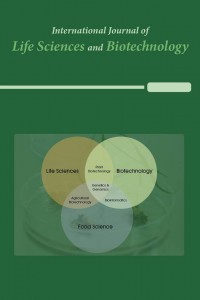Protective Effects of Folic Acid and Vitamin C Against Iron Overload at the in vitro Blood-Brain Barrier
Protective Effects of Folic Acid and Vitamin C Against Iron Overload at the in vitro Blood-Brain Barrier
vitamin C, folic acid, iron overload, blood-brain barrier,
___
- Lin, J.L., et al., Ascorbic Acid Prevents Blood-Brain Barrier Disruption and Sensory Deficit Caused by Sustained Compression of Primary Somatosensory Cortex. Journal of Cerebral Blood Flow & Metabolism, 2010. 30(6): p. 1121-1136.
- Tudisco, C., et al., Comparison Between Folic Acid and gH625 Peptide-Based Functionalization of Fe3O4 Magnetic Nanoparticles for Enhanced Cell Internalization. Nanoscale Research Letters, 2018. 13(1): p. 45.
- Skjørringe, T., L.B. Møller and T. Moos, Impairment of Interrelated Iron- And Copper Homeostatic Mechanisms in Brain Contributes to the Pathogenesis of Neurodegenerative Disorders. Frontiers in Pharmacology, 2012. 3: p. 169.
- Won, S.M., et al., Iron Mediates Endothelial Cell Damage and Blood-Brain Barrier Opening in the Hippocampus After Transient Forebrain Ischemia in Rats. Experimental & Molecular Medicine, 2011. 43(2): p. 121-129.
- Varatharaj, A. and I. Galea, The Blood-Brain Barrier in Systemic Inflammation. Brain, Behavior, and Immunity, 2017. 60: p. 1-12.
- Emoto, M.C., et al., Synthesis and Evaluation as a Blood-Brain Barrier-Permeable Probe of 7-N-(PROXYL-3-yl-methyl) theophylline. Chemical and Pharmaceutical Bulletin, 2018. 66(9): p. 887-891.
- Agus, D.B., et al., Vitamin C Crosses the Blood-Brain Barrier in the Oxidized Form Through the Glucose Transporters. Journal of Clinical Investigation, 2017. 100(11): p. 2842-2850.
- Gordon, N., Cerebral Folate Deficiency. Developmental Medicine and Child Neurology, 2009. 51(3): p. 180-182.
- Yang, S., et al., Identification of two immortalized cell lines, ECV304 and bEnd3, for in vitro permeability studies of blood-brain barrier. PLoS One, 2017. 12(10): e0187017
- Lagrange P, et al., Transendothelial Permeability Changes Induced by Free Radicals in an in Vitro Model of the Blood-Brain Barrier. Free Radical Biology and Medicine, 1999. 27(5-6): p. 667-72.
- Veszelka, S., et al., Comparison of a Rat Primary Cell-Based Blood-Brain Barrier Model With Epithelial and Brain Endothelial Cell Lines: Gene Expression and Drug Transport. Frontiers in Molecular Neuroscience, 2018. 11: p. 166.
- Lockman, J.A., et al., Differential effect of nimodipine in attenuating iron-induced toxicity in brain-and blood–brain barrier-associated cell types. Neurochemical Research, 2012. 37(1): p. 134-142.
- Haorah, J., et al., Oxidative stress activates protein tyrosine kinase and matrix metalloproteinases leading to blood–brain barrier dysfunction. Journal of Neurochemistry, 2007. 101(2): p. 566-576.
- Zheng, W., Monnot, A.D., Regulation of Brain Iron and Copper Homeostasis by Brain Barrier Systems: Implication in Neurodegenerative Diseases. Pharmacology & Therapeutics, 2012. 133(2): p. 177-188.
- Mohammed, M. A., et al., Factors controlling permeability of the blood-brain barrier. Cellular and Molecular Life Sciences, 2016. 73: p. 57-77.
- Kook, S.Y., et al., High-dose of Vitamin C Supplementation Reduces Amyloid Plaque Burden and Ameliorates Pathological Changes in the Brain of 5XFAD Mice. Cell Death & Disease, 2014. 5(2): e1083.
- Agus, D. B., et al., Vitamin C crosses the blood-brain barrier in the oxidized form through the glucose transporters. Journal of Clinical Investigation, 1997. 100(11): p. 2842–2848.
- Smith, A. D., et al., Is folic acid good for everyone? The American Journal of Clinical Nutrition, 2008. 87(3): p. 517–533.
- Yayın Aralığı: Yılda 3 Sayı
- Başlangıç: 2018
- Yayıncı: International Society of Academicians
The Effect of Hemp Seed Oil on Skin and Soap Performance
Production and Quality Evaluation of Wine from Jackfruit Co-Products
Christian Ulysses CAGASAN, Cail Aleksei LİNGATONG, Kyle Miguel PORE, Raymond RAMADA, Christan Daniel RESTOR, Roberta LAUZON
Araceae Familyasına Ait Bazı Taksonların Süt Pıhtılaştırma Özelliklerinin Araştırılması
Mehmet Maruf BALOS, Hasan AKAN, Eda Nur DURMAZ, Fatma Zehra İLGAZ
Fermented Traditional Probiotic Beverages of Turkish Origin: A Concise Review
Oluwaseun ALADEBOYEJE, Nazmiye Özlem ŞANLI
Belkis ATASEVER ARSLAN, İdil SATICI, Enes Furkan ARSLAN, Ayşegül YANIK, Seda KUŞOĞLU GÜLTEKİN
Aktif Yara Örtülerinin Eldesinde Fotosensitizerlerin Kullanımı
Gül Merve GENÇER, Murat AKARSU
Genetiği Değiştirilmiş Doğal Bitkiler: Yatay Gen Transferi
Ünlü Kazak Bilim Adamı Çokan Valihanov’a Göre Kazaklarda Tarım Faaliyetleri
Mesoporous silica nanoparticles, methods of preparation and use of bone tissue engineering
Bitki Hastalık Dayanıklılık Proteinleri; İmmün Savunma Molekülleri Olarak R-gen Ürünleri
